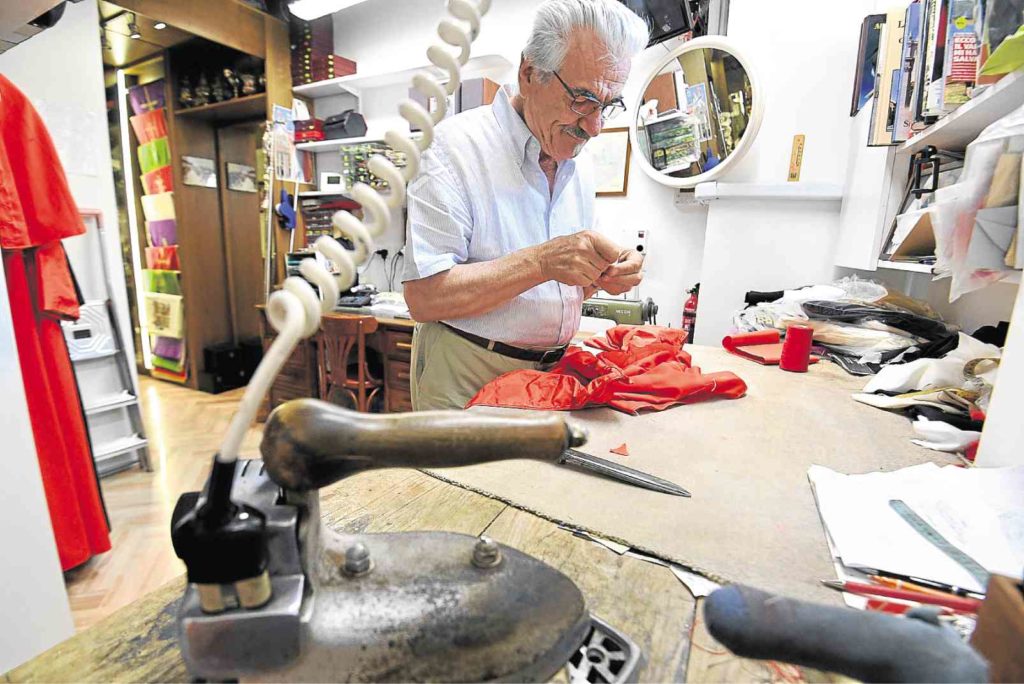
Vatican tailor Raniero Mancinelli: Eighty-year-old Pope’s tailor dresses cardinals from the “North Pole to the South Pole.” —AFP
ROME—Raniero Mancinelli cannot afford to drop a stitch. Pope Francis is creating five new cardinals next week and the race is on to have their scarlet robes ready in time.
The Italian tailor’s family shop, located just outside the walls of Vatican City, hums to the sounds of customers from every corner of the Catholic world.
As a Filipino nun sizes up the least expensive chalice on offer from one display, a young Brazilian priest is buying reams of gold embroidery.
Nearby an Irish colleague is squeezing into a shiny liturgical robe that comes in just one size.
Mancinelli, who turns 80 next month, is on first name terms with many of his visitors. “You’ll be the first black pope,” he jokes with one African bishop, who shoots back, “I hope not!”
But there is little time for tomfoolery. In the workroom at the back of the shop the veteran craftsman’s trusty “Necchi” sewing machine from the 1950s is waiting, and half-finished cassocks and mozzettas (short capes) hang from a rail.
The machine runs like a “Ferrari”, the outfitter says. But it still takes him at least a week to make each new bespoke robe.
Five new so-called “Princes of the Church” from El Salvador, Laos, Mali, Spain and Sweden will be created on Wednesday. Four of them have ordered their ceremonial garb from Mancinelli.
Scarlet silk
While some nipped over to the Italian capital after their nominations to submit to the tape measure, one future cardinal dispatched his personal secretary to the Eternal City with his measurements.
Sometimes Mancinelli’s job is made easier when he has to dress longstanding customers for their big day, though he admits, “I still have to check the measurements a bit, to see if they’ve put on weight around the stomach!”
Biretta
One key part of every outfit sits ready in a range of sizes on a shelf: the scarlet biretta, a four-peaked hat which each new cardinal will receive from the Pope, who places it on their heads as they kneel before him.
Cassock, silk belt and mozzetta must be delivered to the Vatican a few days before the big event. The light, soft fabrics used must come from official suppliers and the color must be exact: there is no picking any old scarlet.
Little luxuries which proud servants of God may have purchased to mark the occasion in the past are not as popular since the election in 2013 of a Pope who called for “a poor Church for the poor.” “They only buy the bare necessities now,” Mancinelli said.
“Under Pope Francis, the cardinals want things a little simpler. Before we only used silk, whereas now we mix silk and wool, fabrics that are a bit cheaper, a bit more modest.”
Sock fashion
When he became a bishop, the then Jorge Bergoglio sought out a simple metal cross from Mancinelli.
And since the Argentine’s elevation to Pope, the minimalist trend has caught on.
The heavy gold crosses set with precious stones on display in one of the shop’s glass cases are on their way to becoming museum pieces. Some prelates even plump for modestly priced wooden crosses.
Outfits generally have become less extravagant down the ages, particularly since the late 1960s.
Out have gone long capes, mantles and flat hats. Gone too are buckled shoes.
Proudest achievement
Long trains, still worn by the more audacious cardinals, are a rarity.
Most now plump for modern, plain shoes and even the once-obligatory matching scarlet socks are optional.
As for the black nonceremonial cassocks, they no longer have to sport 33 buttons, especially if the cardinal is short.
Mancinelli’s proudest achievement is having once decked out 12 new cardinals at once, and he is not about to hang up his scissors.
“I dress them from the North Pole to the South Pole! Why should I put my sewing machine away?” he quips. —AFP


